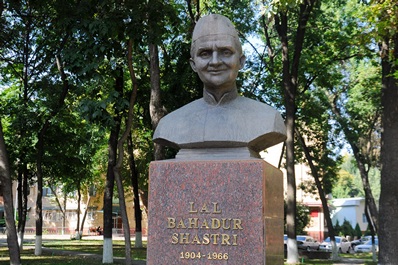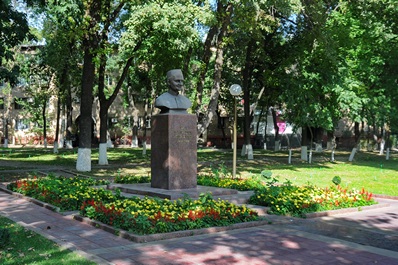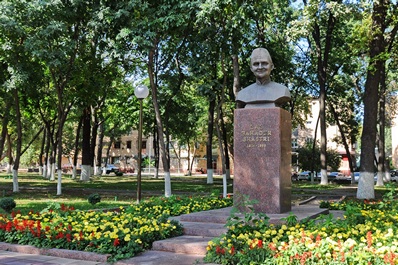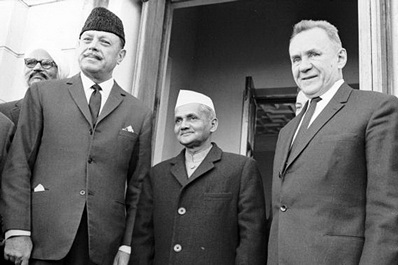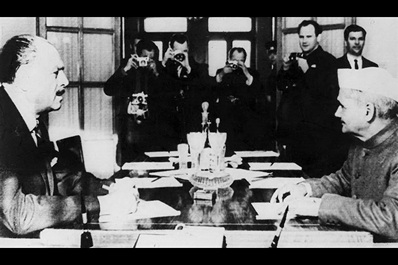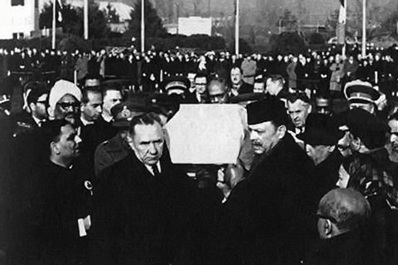For most of the residents of Tashkent Shastri is a city landmark, however for any Indian, Shastri is a great figure belonging to the same level of political figures as Mahatma Gandhi and Javaharlal Nehru. Today there is a monument in the central part of the city on the crossroad dedicated to the person who had greatly contributed to the development of India and who had left a track in the history of not only India, but also Tashkent.
Lal Bahadur Shastri was born on 2 October 1904 in the family of civil servants. Thanks to belonging to the caste of Kayatskha, he had started his education at the age of 4. However, in his later years of form 7 at school, Lal Bahadur stopped using his non-obligatory last name “Varma”, thus refusing his caste origin. Few years later, in January of 1921 while studying in the 10th form, young Lal Bahadur attended a meeting with the participation of Mahatma Ghandi and was so much inspired with his challenge that made a decision to leave the state school and join the movement of nonviolent resistance. He was then firstly arrested and put into prison, later released though as he was still a minor. That same year there was opened a private University of Indian National Congress where Lal Bahadur was one of the first students and in 1925 became a bachelor in philosophy and ethics receiving a title “shastri” translated from Hindi as “scholar”. This is how his title became the part of his name.
After graduation, Shastri turns into an activist of the movement for Independence of India, and in the period of 1925-1946, he was arrested and put into prison where he spent 9 years in total. After independence was announced, Lal Bahadur was appointed the Minister of Internal Affairs in his home town. Later he worked in the position of the Minister of Railways and Transport of the entire India. And finally in year 1964, after the death of Javaharlal Nehru, the majority of the party of Indian National Congress made him the Prime-Minister of the country.
Shastri as a Prime-Minister tried to come to a compromise and withhold from severe reforms. His government faced economic crisis and food shortage, but he tried to find the key to the heart of his people and did a lot to make their lives better. First of all, he decided to fight hunger – new technologies were introduced in agriculture and economic conditions for farmers began to get better. Shastri addressed his nation with an urge to voluntarily give up one meal a week so that the food is saved and the majority of the country supported him: on Monday evening almost all restaurants and cafes in India were closed. He motivated the country to maximize the cultivation of food grains by planting himself wheat instead of lawn, at his official residence in New Delhi. It was during his two-year rule when the structure of the future agricultural corporations was formed.
In August-September 1965, Indo-Pak War took place. Even though they managed to get truce, the situation in the region was still tense. During this period, on 19 October, Shastri delivered his speech in Allahabad and said a phrase that have become a slogan of the Indian people for following years “Jai Jai Jawan Kishan” translated as “Hail the soldier, Hail the Farmer”. However, in order to completely end the resistance between India and Pakistan, the USSR called the two parties to start negotiations in Tashkent in January 1966. After a few days of hard discussions of general political dissents, on 10 January the Prime-Minister of India Shastri and the President of Pakistan Ayub Khan signed Tashkent declaration that served as a stop of war and beginning of the establishment of trade-economic relations between the sides.
That evening the diplomats of India, Pakistan and USSR celebrated the signature of the historic document. Later by 01.00 hrs local time, Shastri felt unwell and an hour later died from a heart attack. The personal assistant of Lal Bahadur remembered later that the Prime-Minister was feeling fine and was about to go to bed, but suddenly stood up and said “Mother, mother” in Hindi and fell. In the morning, the funeral train in Tashkent went until the airport and one of those people who carried the coffin was his former opponent – the president of Pakistan Mukhammed Ayub Khan.
During the short term as a Prime-Minister Shastri managed to firm the position of India on international arena, and was the first citizen of the country who was posthumously awarded the highest order “Bharat Ratna”. The memorial “Vidjai Gat” was opened in Deli in the memory of Shastri and 10 years later, in 1976, in Tashkent where his life path ended, the monument, work of an Uzbek sculptor Yakov Shapiro was unveiled. The monument is done in the shape of a bust on the base made from pink granite. Today it is practically visited by all guests from India. Besides, there is an Indian Cultural Center named after Shastri working in Tashkent, as well as a school teaching Hindi.
NOTE: If you order a taxi and ask to take you to the address of “Shastri” – you will not be taken to the monument, but to the crossroad where there was once an auto station named after Shastri. If you wish to get to the monument, it is better to tell the driver “C-1, old zoo, Shastri monument”. Also, there is a German Church near the monument.


